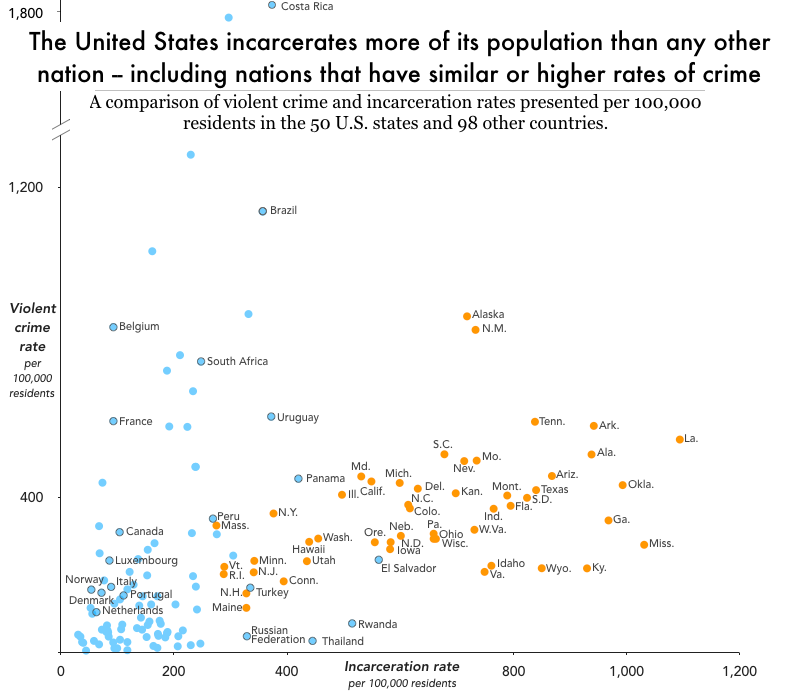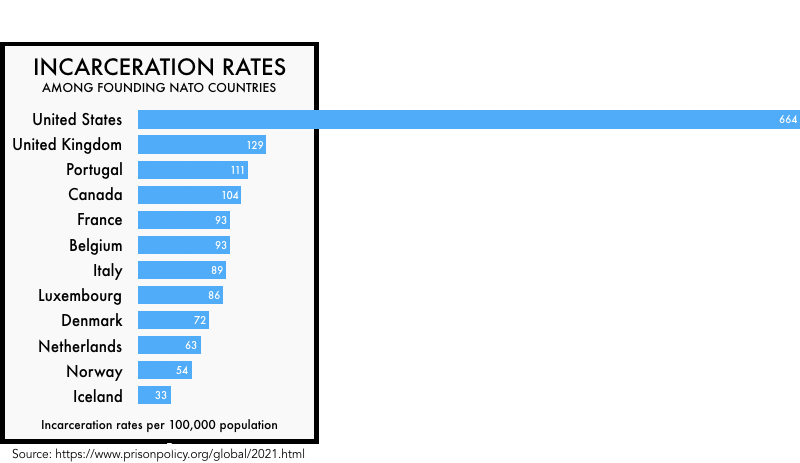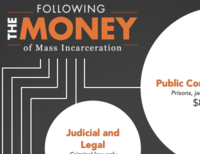States of Incarceration: The Global Context 2021
by Emily Widra and Tiana Herring
September 2021
This report is has been updated with a new version for 2024.
Not only does the U.S. have the highest incarceration rate in the world; every single U.S. state incarcerates more people per capita than virtually any independent democracy on earth. To be sure, states like New York and Massachusetts appear progressive in their incarceration rates compared to states like Louisiana, but compared to the rest of the world, every U.S. state relies too heavily on prisons and jails to respond to crime.
Figure 1. This graph shows the number of people in state prisons, local jails, federal prisons, and other systems of confinement from each U.S. state per 100,000 people in that state and the incarceration rate per 100,000 in all countries with a total population of at least 500,000.
The graphic above charts the incarceration rates of every U.S. state alongside those of the other nations of the world. And looking at each state in the global context reveals that, in every region of the country, incarceration is out of step with the rest of the world.
If we imagine every state as an independent nation, as in the graph above, every state appears extreme. 24 states would have the highest incarceration rate in the world — higher even than the United States. Massachusetts, the state with the lowest incarceration rate in the nation, would rank 17th in the world with an incarceration rate higher than Iran, Colombia, and all the founding NATO nations.
In fact, many of the countries that rank alongside the least punitive U.S. states, such as Turkey, Thailand, Rwanda, and Russia, have authoritarian governments or have recently experienced large-scale internal armed conflicts. Others struggle with “violent crime”1 on a scale far beyond that in the U.S.: South Africa, Panama, Costa Rica, and Brazil all have murder rates2 more than double that of the U.S. Yet the U.S., “the land of the free,” tops them all.
But how does the U.S. compare to countries that have stable democratic governments and comparable crime rates? Next to our closest international peers, our use of incarceration is off the charts:
Figure 2. Compare another state:
or compare just the U.S. with its peers.
The crime rates seen in the U.S. do not require high incarceration rates.
The incarceration rates in every U.S. state are out of line with the entire world, and we found that this disparity is not explainable by differences in crime or “violent crime.”3 In fact, there is little correlation between high rates of “violent crime” and the rate at which the U.S. states lock people up in prisons and jails.
When we compare U.S. states and other nations in terms of both “violent crime” and incarceration, we find ourselves more closely aligned with nations with authoritarian governments or recently large-scale internal armed conflicts. Rather than any of the founding NATO member countries traditionally compared to the United States, the only countries that approach the incarceration rate and “violent crime” rates of the 50 states are El Salvador, Panama, Peru, and Turkey. Every U.S. state, and the United States as a nation, is an outlier in the global context. No other country incarcerates as many people, including countries with similar rates of “violent crime:”

Conclusion
For four decades, the U.S. has been engaged in a globally unprecedented experiment to make every part of its criminal justice system more expansive and more punitive. As a result, incarceration has become the nation’s default response to crime, with, for example, 70 percent of convictions resulting in confinement — far more than other developed nations with comparable crime rates.4 Our new analysis of incarceration rates and crime rates across the world reveals that the U.S.’s high incarceration rates are not a rational response to high crime rate, but rather a politically expedient response to public fears and perceptions about crime and violence.
Today, there is finally serious talk of change, but little action that would bring the United States to an incarceration rate on par with other stable democracies. The incremental changes made in recent years aren’t enough to counteract the bad policy choices built up in every state over decades. For that, all states will have to aim higher, striving to be not just better than the worst U.S. states, but among the most fair and just in the world.
Methodology
Like our report, Mass Incarceration: The Whole Pie, this report takes a comprehensive view of confinement in the United States that goes beyond the commonly reported statistics by more than 100,000 people to offer a fuller picture of this country’s different and overlapping systems of confinement.
This broader universe of confinement includes justice-involved youth held in juvenile residential facilities, people detained by the U.S. Marshals Service (many pre-trial), people detained for immigration offenses, sex offenders indefinitely detained or committed in “civil commitment centers” after completing a sentence, and those committed to psychiatric hospitals as a result of criminal charges or convictions. They are not typically included in the official statistics that aggregate data about prison and jails for the simple reason that these facilities are largely separate from the state and local systems of adult prisons and jails. That definitional distinction is relevant to the people who run prisons and jails, but is irrelevant to the advocates and policymakers who must confront the overuse of confinement by all of the various parts of the justice systems in the United States.
To provide the most up-to-date assessment of incarceration rates in every state we use the most recent datasets available. However, because the federal and state incarceration data are released on different schedules, there are differences in the time periods for which the population data reflect. It is worth noting the federal data comes from 2020 and 2021, at the height of the COVID-19 pandemic, while state data reflect an earlier time period. For more information on these differences, see the sidebar below.
We included these confined populations in the total incarceration rate of the United States and, wherever state-level data made it possible, in state incarceration rates. In most states, these additions have a small impact on the total rate, and they don’t impact the rankings by more than one or two positions for any state. In a few places, however, these other systems of confinement merit closer attention. For example, although Minnesota has one of the lowest overall incarceration rates, Minnesota is second only to the much larger state of California for civil commitment and detention of people convicted of sex offenses. Other states — including Indiana, Iowa, Idaho, and Nebraska — confine large numbers of youth, to the point that the inclusion of these youth adds more than 20 people per 100,000 to their incarceration rates. One state, West Virginia, incarcerates enough youth to increase their statewide incarceration rate by more than 30 people per 100,000.
As a result of our choice to take a broader view of incarceration, this report creates a unique U.S. dataset that offers a complete look at all kinds of justice-related confinement in each state. We explain our specific data sources in more detail below and provide the raw data for the component parts of our calculations in two appendices to this report, Appendix 1: State Data and Appendix 2: Country Data.
Our data on other countries comes from the indispensable Institute for Criminal Policy Research’s World Prison Brief.
Detailed data notes and sources
For the 50 U.S. states, we calculated incarceration rates per 100,000 total population that reflect our holistic view of confinement, which include:
- people in state prison in each state,
- people in local jails in each state,
- people in federal prison from each state,
- people held by the U.S. Marshals Service from each state,
- people held in jails in Indian Country in each state,
- youth held in juvenile justice facilities from each state,
- justice-involved people involuntarily committed to other kinds of confinement in each state (i.e. sex offenders held under “civil commitment” laws and people held in state psychiatric hospitals because of criminal charges or convictions.)
The raw data is available in two appendices — Appendix 1: State Data and Appendix 2: Country Data — and the individual sources were as follows:
- State prisons and local jails: Correctional Populations in the United States, 2019 Appendix Table 1 reports the number of people under prison and jail jurisdiction as of December 31, 2019. This report, published in August 2021, is the newest available data that provides a combined state prison and local jail count that avoids double counting state prisoners being held in local jails. (A small number of states have contractual relationships with local jails that place large numbers of state prisoners in local jails. Failing to correct for this double counting would significantly and incorrectly increase the incarceration rate for select states.)
- Federal prisons and U.S. Marshals Service: While federal prosecutions are nominally the result of federal policy, we attributed federal convictions to individual states in part because federal prosecutions are of state residents and in part because federal prosecutions are often coordinated with state prosecutors and state law enforcement. (In this way, our methodology departs from the way that the Bureau of Justice Statistics calculates state rates. In Correctional Populations in the United States, 2017-2018, U.S. Marshals Service detainees are not included at all, and other federal prisoners are included in the total national incarceration rate but do not affect state incarceration rates.)
To develop estimates of the number of people in federal prison from each state, we developed a ratio of the state of legal residence for the Bureau of Prisons population as of April 2019 — based on FOIA request 2019-04597 — and applied it to the total federal prison population of 155,078 reported by the Federal Bureau of Prisons as of July 29, 2021. While we did not have state of residence information for this federal population, we used the same ratio to reallocate these people to states as we did for those under BOP jurisdiction. We reasoned that people under federal jurisdiction, regardless of status (convicted, pretrial, or in transit), would likely come from the states in the same proportions. We applied the same ratio to reallocate the 62,329 average daily population in U.S. Marshals Service’s custody in FY 2020 to the states.
- Indian country jails: Jails in Indian Country, 2017-2018 Appendix Table 1 reports the average daily population of adults and youth held in jails in Indian country in June 2018 by state. Unfortunately, this survey did not include data for 9 facilities: four in Arizona, two in Montana, one in North Carolina and two in South Dakota. For our calculated national incarceration rate, we used the number estimated by the Bureau of Justice Statistics (which imputes data for non-reporting facilities). For the state rates, we used the reported numbers, since estimates were not available by state.
- Youth confinement: Because the United States confines large numbers of youth through the juvenile justice system, we included these youth in our national and state incarceration rates. Youth confined in places other than prison are not included in other countries’ incarceration rates in this report, but their inclusion would not change other countries’ rates much anyway. The 37,529 confined youth in the U.S. add 11.2 incarcerated people per 100,000 population to the national rate. Canada’s rate, by comparison, would only increase by 1.9 per 100,000 based on the juvenile average daily population in custody as reported by Statistics Canada and the national population reported by the World Prison Brief. Italy’s incarceration rate would increase by less than 1 person per 100,000 if we incorporated juvenile populations reported in Italy’s Juvenile Offenders Detention Alternative in Europe National Report. In England and Wales, youth in Immigration Removal Centres are already included in that nation’s data. Juveniles in other kinds of facilities in England and Wales are not included in their data, but including them would increase the overall rate for England and Wales by less than 1 person per 100,000. We did not make these adjustments because for most countries, these data are not available or are not comparable to the system of youth confinement in the U.S.
For youth in the U.S., the Juvenile Residential Facility Census Databook: 2000-2018 reports the number of people younger than 21 who were detained or committed in residential placement facilities as of October 24, 2018, the most recent year for which data are available. We included the national total of 37,529 in the national incarceration rate, but the totals for the states do not match the U.S total due to rounding for anonymity. (For more on this population, see our more detailed report Youth Confinement: The Whole Pie.) - Involuntary commitments: The number of people involuntarily committed to state psychiatric hospitals because of involvement with the criminal justice system (either for evaluation/treatment as incompetent to stand trial or for treatment after being found not guilty by reason of insanity) come from pages 91-92, 98-99, and 103-104 of the August 2017 NRI report Forensic Patients in State Psychiatric Hospitals: 1999-2016, reporting 2014 data by state for 37 responding states. We did not attempt to estimate these populations for non-responding states; we counted them as zeros. Therefore, the incarceration rates for these states may be understated if they do confine people under similar conditions. Finally, we made a correction to the NRI data for the number of people held for pre-trial evaluations in Arkansas, after speaking with an official from the state’s program for forensic patients. The NRI report shows a pre-trial evaluation population of 1,406 in 2014, but this number included outpatient evaluations. The number of inpatient initial criminal forensic evaluations that year was 9.
The data on people convicted of sexual offenses who are detained or committed under civil commitment laws after their sentences are complete comes from an annual survey conducted by the Sex Offender Civil Commitment Programs Network shared by SOCCPN President Shan Jumper. Except for Arizona, Massachusetts, Nebraska, and North Dakota, all counts are from their 2020 survey (Arizona, Massachusetts, and Nebraska did not respond to the 2020 survey, so their counts are from 2017; North Dakota did not respond in 2020 or 2017, so its count is from 2016.) - Population data for each state, used to calculate the incarceration rates, reflect the total resident population on April 1, 2020 as reported in the Census Bureau’s 2020 Apportionment Data in Table 2.
Three additional categories of confinement are included in the national incarceration rate for the United States, but not in state rates, because state-level data were not available:
- Territorial prisons: The incarcerated populations under the jurisdictions of the U.S. Territories of American Samoa, Guam, and the U.S. Virgin Islands, and U.S. Commonwealths of Northern Mariana Islands and Puerto Rico are reported in Prisoners in 2019 Table 21, reporting data for December 31, 2019.
- Immigration detention: The average daily population under the custody of Immigration and Customs Enforcement (ICE) as of July 8, 2021 is reported by ICE in their Detention Management statistics.
- Military prisons: Prisoners in 2019 Table 19 reports data as of December 31, 2019.
For the incarceration rates of other countries, we used the most recent incarceration rate data available from the Institute for Criminal Policy Research’s World Prison Brief in May 2018. For this report, we decided to accept the World Prison Brief’s definition of country, choosing to exclude countries only for reasons of population size. To make the comparisons more meaningful to U.S. states, we’ve chosen to include only independent nations with total populations of more than 500,000 people.
In order to make the graph comparing the founding NATO nations to individual states, however, we had to make two exceptions to this policy. First, we included Iceland, which is a founding NATO member, even though its population is below 500,000. We also aggregated the total incarcerated and total population data for the three separate nations of England and Wales, Scotland and Northern Island, into the one member of NATO, the United Kingdom.
A note about the District of Columbia and U.S. territories: This report focuses on comparing individual states to other countries, so we chose to not include the District of Columbia, American Samoa, Guam, Northern Mariana Islands, Puerto Rico, or the U.S. Virgin Islands in the main graphic in this report, although we did make separate NATO comparison graphics for these places. However, the incarceration data for D.C. and the territories, where they exist, are in Appendix 1: State Data and the final incarceration rate calculations for D.C. and the territories are:
| Jurisdiction | Incarceration Rate |
|---|---|
| District of Columbia | 911 |
| American Samoa | 358 |
| Guam | 401 |
| Northern Mariana Islands | 362 |
| Puerto Rico | 307 |
| U.S. Virgin Islands | 517 |
“Violent crime” analysis and methodology
Our definition of “violent crime”5 included four elements: murder and nonnegligent manslaughter, rape/sexual violence, robbery, and aggravated/serious assault.6
For the U.S.’ national and state violent crime data, we used the combined rates of murder and nonnegligent manslaughter, rape/sexual violence, robbery, and aggravated/serious assault per 100,000 reported in the FBI’s Universal Crime Reporting program’s Tables 4 and 5. We used the estimated number of crimes because, in most cases, the estimated and reported numbers did not vary significantly. However, since some states had a low percentage of agencies reporting, estimates helped to avoid undercounting.
For international violent crime data, we used the following spreadsheets from the United Nations Office of Drugs and Crime: serious assault, robbery, homicide rates (option with map)7, and sexual violence.8 We added the crime rates per 100,000 for each crime category together to get the total violent crime rate for each country. We only included countries that had complete violent crime data and populations of at least 500,000.
Privacy policy
To customize this report with state data that you are most likely to find relevant, this report makes an educated but unrecorded guess about your location based on your IP address. Where we can’t make this guess, the page may request your location for that purpose. If you gave us this permission, we discarded your location data as the page finished loading. If you did not give us this permission — or if your browser was configured to decline permission automatically — this report simply gives a more generic experience.
Acknowledgements
All Prison Policy Initiative reports are collaborative endeavors, but this report builds on the successful collaborations of the 2014, 2016, and 2018 versions. Beyond the original structure developed by data artist Josh Begley, the authors of this year’s report are particularly indebted to Jordan Miner, Matt Mitchell, and Peter Wagner for helping us upgrade the technology in this report and to the Institute for Crime & Justice Policy Research for aggregating comparable world incarceration data in the invaluable World Prison Brief.
This report was made possible by the Public Welfare Foundation, and by generous contributions from our individual donors, who give us the resources and the flexibility to quickly turn our insights into new movement resources.
About the authors
Emily Widra is a Senior Research Analyst at the Prison Policy Initiative. She is the organization’s expert on health and safety issues behind bars, including the coronavirus in prisons; over the past year, she has curated the Prison Policy Initiative’s virus response page, which tracks the policy changes that prisons have made in response to the COVID-19 pandemic. Her previous research also includes analyses of mortality in prisons and the combined impact of HIV and incarceration on Black men and women.
Tiana Herring is a Research Associate at the Prison Policy Initiative. Joining the Prison Policy Initiative during the COVID-19 pandemic, she helped the organization quickly increase its output of analyses about the coronavirus behind bars and was the author of States of Emergency: The Failure of Prison System Responses to COVID-19. Tiana’s work also includes analyses of several important drivers of mass incarceration, including outdated “felony theft” thresholds, the war on drugs, needless parole denials, and money bail.
About the Prison Policy Initiative
The non-profit, non-partisan Prison Policy Initiative was founded in 2001 to expose the broader harm of mass criminalization and spark advocacy campaigns to create a more just society. The organization is known for its visual breakdown of mass incarceration in the U.S., as well as its data-rich analyses of how states vary in their use of punishment. It sounded the national alarm about the threat of coronavirus to jails and prisons with its March 2020 report No need to wait for pandemics: The public health case for criminal justice reform, and its data-driven coverage of the pandemic behind bars continues to advance the national movement to protect incarcerated people from COVID-19.
Footnotes
We recognize there are inherent problems associated with designating crimes as “violent” or “nonviolent.” For more information on why this metric was used, see “How and why we measured ‘violent crime’” below. ↩
As of 2018. ↩
The distinction between “violent” and other crime types is a dubious one; what constitutes a “violent crime” varies from state to state, and acts that are considered “violent crimes” do not always involve physical harm. The Justice Policy Institute explains many of these inconsistencies, and why they matter, in its comprehensive and relevant report, Defining Violence. ↩
For example, Canada, England and Wales, Finland, and Germany are more likely to use fines and/or warnings instead of incarceration. ↩
For a more detailed analysis of the dubious distinction between “violent” and other offense types, we recommend the Justice Policy Institute’s report, Defining Violence, explaining many of these inconsistencies and why they matter. ↩
The federal government consistently uses these categories — murder and nonnegligent manslaughter, rape/sexual violence, robbery, and aggravated/serious assault — to define “violent crime” across the relevant reporting agencies: the Federal Bureau of Investigation, Bureau of Justice Statistics, and National Institute of Justice. Therefore, we applied the same categorization of “violent crime” to state data for comparison purposes, although some states may or may not exclude these categories in their state-specific definitions of “violent crime.” ↩
There are 14 spreadsheets available for international homicide data. We chose the “option with map” because it seemed to be the most similar to the other datasets we used to calculate international “violent crime” rates. ↩
The serious assault, robbery, and sexual violence spreadsheets use reported data, while the homicide rate data reports estimates. The spreadsheets provided longitudinal data but we only used the crime rate data from the most recent year available. All of the data used were already presented as a rate per 100,000. ↩
Events
- November 13-15, 2024:
Members of our Research and Advocacy teams will be attending the American Society of Criminology annual meeting in San Francisco from November 13 through the 15th. Please reach out if you’d like to set up a meeting. - November 14-16, 2024:
Members of our Research and Advocacy teams will be attending a convening at the University of Texas in Austin from November 14 through the 16th. Please reach out if you’d like to set up a meeting.
Not near you?
Invite us to your city, college or organization.






